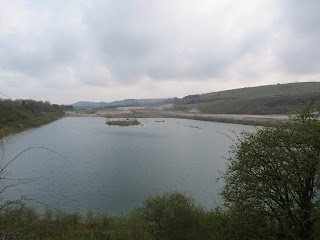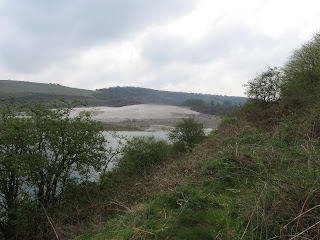The last day of April proved to be a fortuitous one, with warmer temperatures (13 degrees C), lighter winds (NW) and largely clear skies. Buckinghamshire was my domain throughout the day, with 6 County Year Ticks (CYT) for my efforts...
Following a mid-morning call from Adam Bassett, MARLOW proved to be my first destination, where in the PUMP LANE VINEFIELDS, I soon located the two NORTHERN WHEATEARS (male and female) and the single WHINCHAT (see images below).
I then joined Adam and Dave Cleal at the MARLOW LOW GROUNDS where almost at the end of LOWER POUND LANE, the WOOD WARBLER was still trilling from the Willow and Alder Carr every five minutes or so. Unfortunately, it was frequenting the back garden of a large property and we were only to get rather distant views as the bird sang and flitted through the Willow branches. It was nothing like as bright as yesterday's Wilstone bird. With this being such a late spring and many of the woodlands three weeks behind in flowering, exceptional numbers of passage Wood Warblers have been recorded this spring, many in locations close to water, perhaps 75 in total. Exceptional too has been the fact that Adam has found three separate singers, all within the Marlow area.
Whilst standing listening and searching for the Wood Warbler, 3 HOBBIES glided overhead in the heat of the early afternoon sun, several Common Buzzards and Red Kites, a Great Spotted Woodpecker, food-carrying Common Treecreepers and two Goldcrests also seen. The water meadows themselves held a pair of Egyptian Geese tending 5 small young (see picture below). Butterflies emerging in the sun included Brimstone and Green-veined White.
Neighbouring SPADE OAK NATURE RESERVE (LITTLE MARLOW) very quickly yielded me GARDEN WARBLER, with 4 singing males in the south hedgerow, with 13+ Blackcaps and 5 Common Chiffchaffs singing. Not much on the pit apart from 12 Coot, 6 Lapwing, 7 Gadwall, 1 Egyptian Goose, 1 COMMON SNIPE, 44 Argenteus Herring Gulls, 2 Mute Swans and 5 Common Terns.
Checking the SCHOOL LANE cereal fields in OLD AMERSHAM, I was surprised to find a single LAPWING feeding. It also provided me with an opportunity to get some nice Rook shots as they busily filled their crops to feed the young birds in the rookery across the road. A male Muntjac crossed the field too.
Thanks to some guidance from Graham Smith, I soon connected with both COMMON CUCKOO and LESSER WHITETHROAT at COLLEGE LAKE BBOWT - the former calling from the railway embankment in the NE corner of the reserve and the latter rattling and warbling from the scrub in the far NW corner. Both were new for me.
Also a Site Tick for me was FIRECREST at WESTON TURVILLE RESERVOIR: a pair showing very well in ivy-clad trees, Holly and Birch scrub just beyond the last outbuilding in the grounds of Perch Cottage, perhaps 45 yards in from the road. I managed a few images but the birds were particularly mobile (see below). A COMMON SHREW that ran across the path was also my first of the year.
The two Firecrests - typically flitting
I finished off my day with a visit to SHARDELOES LAKE where I was surprised to see breeding in full swing. No less than three broods of Mallard were on the water, with two well grown young and groups of 4 and 7 ducklings. Coot nests numbered 12, with one pair already feeding a single tiny youngster (adults numbered 42 in total). The Mute Swans were also nesting (see pix below).
The male GREAT CRESTED GREBE was busy feeding, with 4 Little Grebes, 13 Tufted Duck, 3 pairs of GADWALL and 3 MANDARIN DUCKS (2 drakes) present on the lake.
Other species noted included COMMON KINGFISHER, Great Spotted and Green Woodpecker, 2 Red Kite, 3 Stock Dove, a singing male Song Thrush, single singing males of both Blackcap and Common Chiffchaff, Wren, Robin (feeding young), 3 Goldfinch and 2 Barn Swallows.



















































